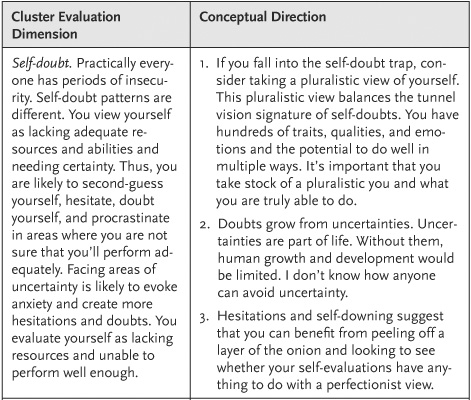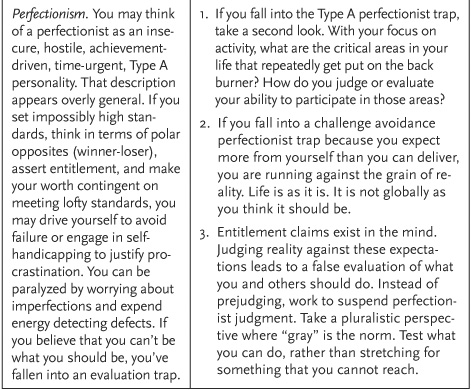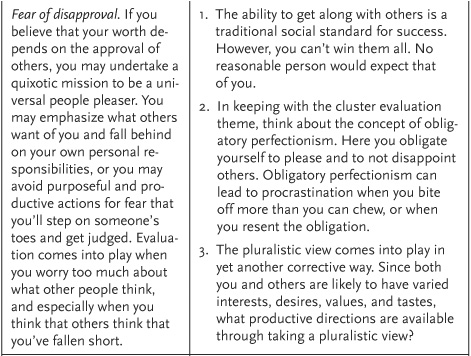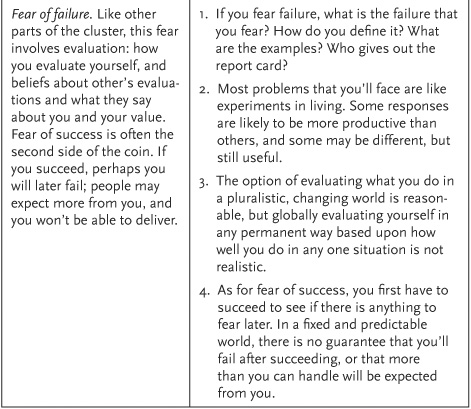End Procrastination Now! (14 page)
Read End Procrastination Now! Online
Authors: William D. Knaus

As you may recall from
Chapter 1
, complex procrastination is a combination of procrastination plus a coexisting condition, such as anxiety, self-doubt, or low tension tolerance. Complex procrastination delays include delaying the task and putting off dealing with the complex co-occurring condition that contributes to procrastination. Let's suppose that you want to convey unpleasant
information to a coworker about how the person's delays are impeding a project. You delay because you have a confrontation anxiety. You believe that if you assert your interests, this will lead to an unpleasant verbal encounter that you tell yourself you'll lose. By ending procrastination caused by your confrontation anxiety, you may persuade the coworker to follow through in a timely way. Thus, you have a double gain.
A procrastination habit that co-occurs with self-doubts is a common situation. Here, procrastination can be both a symptom and a cause. You put off a timely and relevant activity. You experience an ongoing nagging anxiety about the incomplete task. You continue to think that you can't cope with the complexity of the activity. This adds to your uncertainty about performing effectively. This self-doubt is a double jeopardy. It can both trigger procrastination and result from procrastination.
A self-doubt state of mind rarely occurs without other co-occurring conditions that also lead to procrastination. Self-doubts, perfectionism, fear of disapproval, fear of failure, and fear of tension are part of the procrastination evaluative style cluster where you have multiple coexisting problem conditions, but one
evaluation
theme and some branch issues to address.
Let's take a look at an evaluation procrastination cluster, shown in
Table 4.1
. I'll briefly describe what distinguishes each aspect and give a conceptual direction to overcome procrastination.
When you boil down related cluster conditions into a core theme, you may find complex clusters less imposing. As you engage in productive activities to progress on those activities and cut back on evaluative anxieties, you can shorten your learning curve for addressing and overcoming this form of complex procrastination.
When you modulate, you adjust a tone or volume to change a signal. Let's look at the language of commitment and challenge as procrastination modulators. Then, we'll look at proactive coping to boost your do-it-now signals to promote productive outcomes.
TABLE 4.1
Evaluation Procrastination Cluster




American diplomat and scientist Ben Franklin advised committing only to what you are willing to do, then doing it. A commitment is a pledge or a promise to yourself or to someone else that you'll follow through on a responsibility now or at a future time. You may have competing commitments, such as saving for a new home, having the money to enjoy life, and investing for retirement. Such competing commitments suggest that one thing or another is going to get put off.
You may commit to losing weight, improving the quality of your work products, and ending procrastination practices. However, without a plan and an intention, this is like a promissory note with no due date. If you delay, you're on the slippery procrastination slope.
If you choose to stay off the slippery slope, before you voluntarily make a commitment, ask yourself: What am I doing this for? (It's easy to skip this step.) A few more preliminary questions are in order: What do you want to accomplish? What is required? What resources do you need? How long do you expect the process to take? What are the constraints? Now you may be ready to commit to an action of your choice.
A phrase as simple as “I will do this” is a commitment. The stronger your sense of intent, the more likely it is that you'll follow through. However, you're not off the procrastination slope until you start acting with purpose and intent.
Organizations that live up to their commitments to produce high-quality products and deliver better-than-average customer service are likely to keep their customers and add to their customer base. View yourself as your own best customer. What service do you believe you deserve from yourself?
Psychologist James Blascovich found that if you believe you have the resources to meet or exceed the demands of a situation, you will feel challenged. In a challenge state, you are likely to feel excited about meeting the challenge and overcoming the obstacles. This positive
challenge stress
promotes cardiac efficiency and mental agility.
Perceptions of threat have the opposite effect. If you believe that you don't have what it takes to meet a challenge, you are likely to feel threatened. Threat decreases your efficiency and mental agility. This state of mind also increases your chances of procrastinating.
Threat perceptions are part of a process of coming to a conclusion about whether it's worth taking the initiative to follow through. However, perceptions are often filtered through beliefs.
Threat stresses
commonly arise from irrational worries, resentments, and negative thoughts, such as, “I don't have what it takes.” “I'll be embarrassed.” “I'll look like a fool.” This language of threat portends a psychic danger, and this danger is a red-carpet invitation to procrastination.
A shift from threat to challenge language can pull the red carpet out from under procrastination. The language of challenge involves using action terms to structure a positive process of moving from procrastination threat thinking to challenge thinking and follow-up actions. When you use challenge language, you give yourself directions for taking specific concrete steps toward constructive goals. This is a conscious assertion and direction, as you see in the following example:
This is my goal or opportunity: _____________________________.
This is what I'm prepared to do: ____________________________.
This is when I'll start: _____________________________________.
This is how I'll benefit: ____________________________________.
This is how I'll persist: ____________________________________.
Challenge language thinking has nothing to do with inspirational statements, such as, “You can do it. You'll succeed.” If platitudes and slogans were effective, we'd all use them, and there would be no procrastination.
When you proactively cope, you prepare yourself to meet challenges before they occur. This proactive approach helps prevent last-minute procrastination rushes and can promote a low-stress and high-productivity approach to meeting work challenges.
Is proactive coping a new idea? Hardly. It's been part of the organizational lexicon for generations. However, the label and the process invite research initiatives. The preliminary results are encouraging. This forward-looking approach to managing goals (challenge outlook) appears to be effective in promoting positive results and less stress. Positive striving through taking proactive steps appears to be associated with a sense of well-being.
When you proactively cope, you appraise the situation using the information you have available. To fill gaps, you research key points. You figure out what you can accomplish. This self-regulatory format is used for addressing challenges before they become stressful.
You are scheduled for a problem-solving meeting on how to maintain ongoing performance review records and increase their accuracy and value. You're nervous about the meeting. Your usual procrastination decision is to think that you'll get to this planning stage later. Then you let time run until immediately before the meeting and rush to finish.
Keeping on top of performance review information is appealing. You don't relish the thought of a flurry of last-minute effort to get performance reviews done, using the last two weeks or so for
a reference. Facing subordinates with incomplete information is an added strain. So, how do you proactively cope under such circumstances?
Your proactive coping goal for the meeting is to act proactively. You'll take a look at the issue and prepare a position. You'll research the area and distill your findings into a position. You may not precisely know your position before you start. That is the purpose of proactively doing the research.
END PROCRASTINATION NOW! TIP
Four Steps to Proactive Coping
Step 1: Accept ambiguity and uncertainty as normal for upcoming situations
. You help yourself reduce fears of uncertainty through exercising your proactive coping resources. You won't see the complete picture until you engage the challenge; the more knowledge you develop, the more gaps you can discover. That is typically better than relying on an illusion that the future will be better without your making any effort today.
Step 2: Think about potential stumbling blocks that can predictably get in the way, such as stress thinking.
Plan to proactively cope with this and other expected impediments in advance of their occurrence.